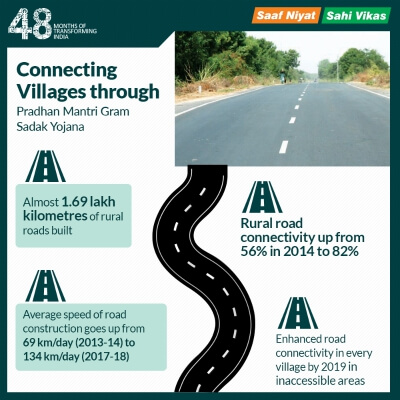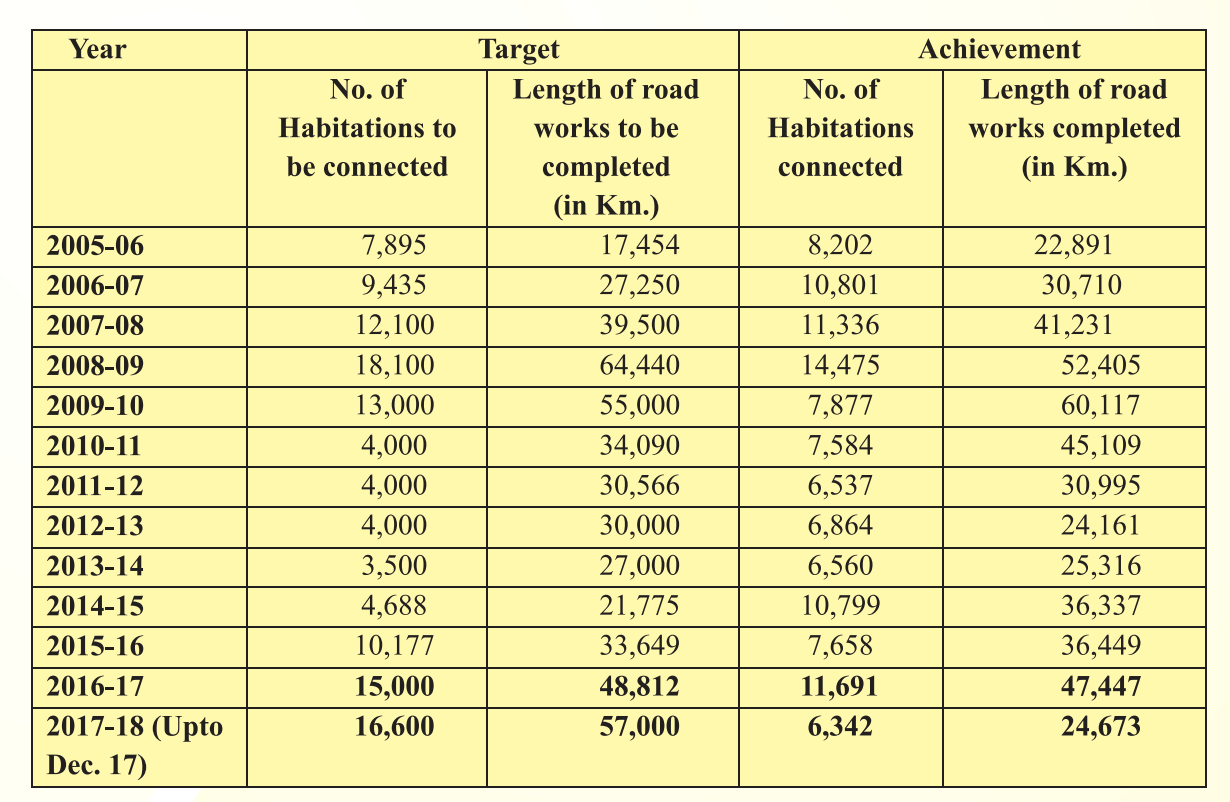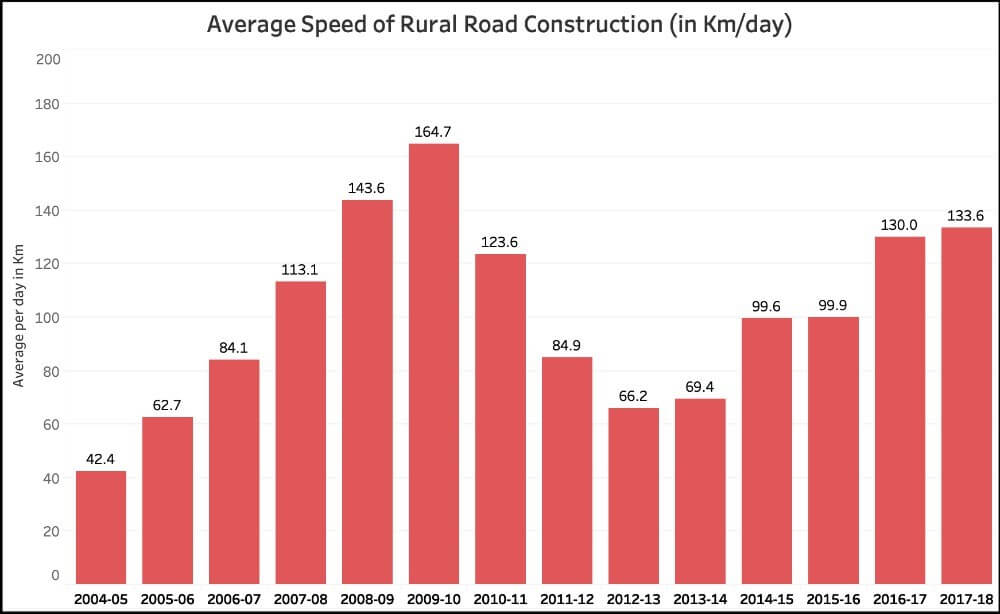[orc]The BJP government published an infographic on the 48-months portal that makes four claims about the Rural Road construction or the Pradhan Mantri Gram Sadak Yojana (PMGSY). This article is a fact check of those claims.
The BJP government published an infographic on the 48-months portal that makes four claims about the Rural Road construction or the Pradhan Mantri Gram Sadak Yojana (PMGSY). This article is a fact check of those claims.
What is the Pradhan Mantri Gram Sadak Yojana?
According to an answer provided in Lok Sabha, ‘Pradhan Mantri Gram Sadak Yojana (PMGSY) is a one-time special intervention to provide rural connectivity, by way of a single all weather road, to the eligible unconnected habitations in the core network though rural roads is a State subject.’
As per the annual report of the Ministry of Rural Development (2017-18) , ‘a major thrust to the development of rural roads was accorded at the beginning of the fifth five year plan in 1974, when it was made a part of the minimum needs programme. In 1996, this was merged with the basic minimum services (BMS) programmes. The PMGSY was launched in the year 2000 as a Centrally Sponsored Scheme.’
What length of rural roads have been built in the last 4 years?
The first claim is that almost 1.69 lakh kms of rural roads were built in the last 4 years. According to the annual report of the Ministry of Rural Development (2017-18), a total of 3,38,024 kms of roads have been constructed to connect 1,30,974 habitations that were previously unconnected by all-weather roads since the inception of the PMGSY. Further, upgradation work of 1,75,903 kms and 12,984 kms has been taken up in phase I and phase II of PMGSY respectively.
Physical targets under this scheme were laid down since the year 2005-06. As per data provided in the annual report of the Ministry of Rural Development (2017-18), a total of 1,47,237 kms of rural roads were constructed during the last four years of UPA-1 (2005-06 to 2008-09). During UPA-2, a total of 1,85,698 kms of roads were constructed under PMGSY in the five-year period between 2009-10 to 2013-14. On the other hand, during the first four-year period of the current government, a total of 1,68,975 kms was constructed between 2014-15 & 2017-18.
Claim: 1.69 lakh kms of rural roads built in the last 4 years.
Fact: During the first four-year period of the current government, a total of 1,68,975 kms was constructed between 2014-15 & 2017-18. Hence the claim is TRUE. However, this is in line with the achievement of rural roads construction during the UPA. A total of 1,47,237 kms of rural roads were constructed during the last four years of UPA-1 (2005-06 to 2008-09) and during UPA-2, a total of 1,85,698 kms of roads were constructed under PMGSY in the five-year period between 2009-10 to 2013-14.
Has the speed of rural road construction increased?
The second claim is that average speed of rural road construction increased from 69km/day in 2013-14 to 134 km/day in 2017-18. The website of the Ministry of Rural Development shows that the average road length constructed per day was 69 km in 2013-14 and has increased to 130 km in 2016-17. But this presents only half the picture.
Data from the annual reports of the ministry, the PMGSY briefing book and the answer to a question in the Lok Sabha reveals that the highest ever average speed of rural road construction was achieved in 2009-10 followed by 2008-09, both during the UPA. It is quite clear that average speed of construction was higher than 134 km/day in both 2008-09 and 2009-10. Hence this is not the first time that such speed was achieved.
Claim: Average speed of rural road construction increased from 69kms/day in 2013-14 to 134kms/day in 2017-18.
Fact: The average road length constructed per day was 69km in 2013-14 and has increased to 134 km in 2017-18. Hence, the claim is TRUE. However, this is not a record high in the speed of rural road construction and a greater speed was achieved by the UPA government in both 2008-09 and 2009-10.
Has rural road connectivity increased and by how much?
The third claim is that rural road connectivity increased from 56% in 2014 to 82% villages. The impact assessment report of the Pradhan Mantri Gram Sadak Yojana (PMGSY) states that ‘PMGSY was launched in December 2000 as a special intervention of the Government of India with the broad objective of ensuring sustainable poverty reduction. The scheme aims to provide good quality all-weather single connectivity road to every eligible habitation. Rural roads are a state subject under the Constitution and as such are the basic responsibility of the states. However, under the PMGSY, the construction of good quality and well-engineered roads are fully funded by the Government of India. Maintenance of these roads is the responsibility of the states. The year 2013 saw the launch of PMGSY-II with the objectives of consolidating the existing rural road network and upgrading existing rural roads that provide connectivity to rural growth centres. PMGSY-II envisages sharing of construction costs between the Centre and the states with maintenance costs continuing to be funded fully by the states.’
In the answer provided in the Lok Sabha in July 2018, the government mentioned that the number of eligible unconnected habitations as per the core network under PMGSY is 1,78,184 out of which the Ministry has sanctioned 1,64,913 habitations till 30th June, 2018. It is also mentioned that the States have reported to have connected 1,41,311 habitations by all-weather road till 30th June, 2018. The Lok Sabha answer also makes a mention of the roads built through State sponsored schemes and that 16,380 habitations were connected through such schemes taking the total connectivity to 1,57,691 habitations. State wise details are provided in another Lok Sabha answer. Hence, 1,57,691 out of 1,78,184 (or 88%) of the habitations which were eligible for PMGSY have been connected.
According to the details provided in another Lok Sabha answer in August 2014, out of the total of 1,78,184 habitations eligible under PMGSY, 99696 habitations have been connected by June 2014 (during the tenure of the previous government). This implies that 56% of the total eligible habitations have been connected by the time the current government took over. This proves that the numbers in the claim correspond to the percentage of habitations connected as per the target set for the period and not all habitations of the country.
Claim: Rural road connectivity increased from 56% in 2014 to 82% villages.
Fact: By June 2014, 56% of the target habitations under PMGSY were connected by roads. By July 2018, 88% of the target of PMGSY (II) have been connected by roads. Hence, the claim is TRUE. But, it has to be noted that the percentages correspond to the target under PMGSY and not the total habitations in the country.
What about Road connectivity in every village?
The fourth claim is that there will be enhanced road connectivity in every village by 2019 in inaccessible areas. As per a press release of the government in April 2018, connectivity was provided to 1,52,124 habitations (85.37% against 1,78,184 eligible habitations). As per an answer provided in the Lok Sabha in July 2018, States have reported to have connected 1,41,311 habitations by all-weather road till 30th June, 2018. The Lok Sabha answer also makes a mention of the roads built through State sponsored schemes and that 16,380 habitations were connected through such schemes taking the total connectivity to 1,57,691 habitations. State wise details are provided in another Lok Sabha answer. Hence, 1,57,691 out of 1,78,184 (or 88%) of the habitations which were eligible for PMGSY have been connected. Since the target is to connect all eligible habitations by March 2019, this claim remains unverified.
Claim: Enhanced road connectivity in every village by 2019 in inaccessible areas.
Fact: Since the target is to connect all eligible habitations by March 2019, this claim remains UNVERIFIED.
This story is part of a larger series on the 4-years of the Modi government. This series has been made possible with the flash grant of the International Fact Checking Network (IFCN). Read the rest of the stories in this series here


